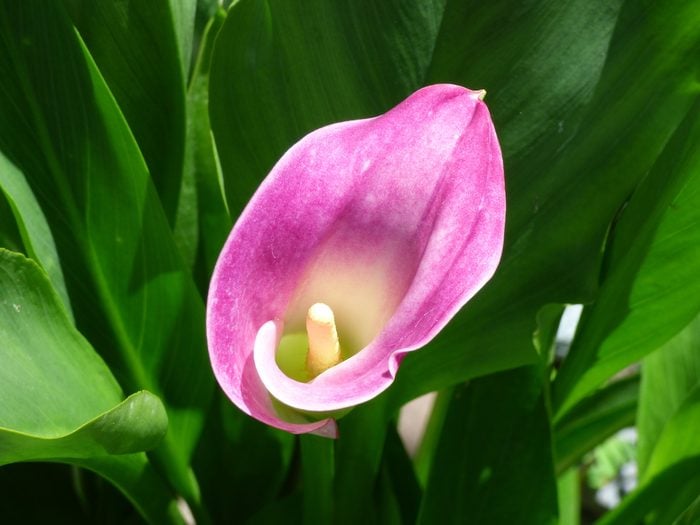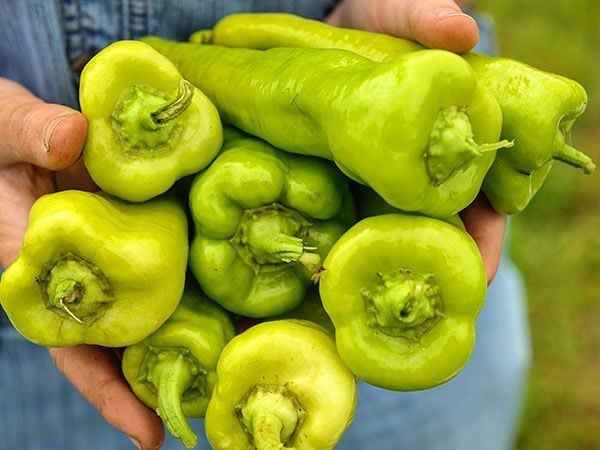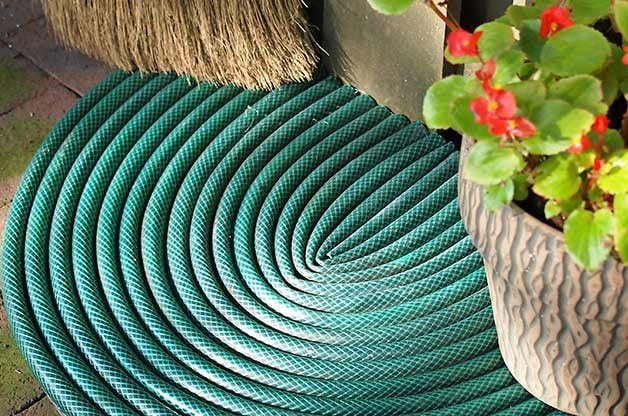
New Uses for Old Garden Hoses
Holey hose? Give it another useful purpose.
- Set four wooden posts in a square and weave the hose around them to make a simple compost bin.
- Craft a basket out of a hose and zip ties. We found this project by artist Chase DeForest on Pinterest. It’s genius!
- Shape your hose into a loose circle; add embellishments, like gardening gloves or a few tools, for a fun wreath to hang on your shed or near a potting area.
- Make a doormat by cutting your hose into lengths, putting corks in the cut ends and gluing the pieces to a worn out mat.
- Place hose segments around swing-set chains to protect tiny fingers. Or put small lengths of hose around bucket handles for a more comfortable grip.
Bonus Tip: Solicit for deals! Ask friends if they’ve got any of these items they’d like to offload. If you’re willing to spend a few dollars, check rummage sales and thrift stores for deals.

Recycle Old Wine Bottles in the Garden
Enjoy your favorite wine even after the last sip.
- Make a bottle tree in your backyard and train colorful flowering vines to climb it. Clematis, trumpet vine or morning glory will give you a simple, sweet look.
- Plant bottles upside down around a garden bed or path for a whimsical edging.
- Fill bottles with water, flip them upside down in your planters, and they’ll slowly water your plants, in case you forget or are going out of town.
- Write plant names on wine corks; stick them on skewers and use them as garden markers.
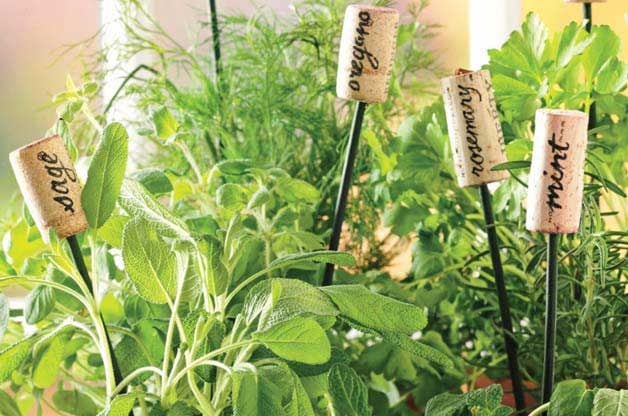
Bonus Tip: Take it up a notch! When upcycling for the backyard, nothing is off limits. Be creative, think outside the box and don’t be afraid to experiment.
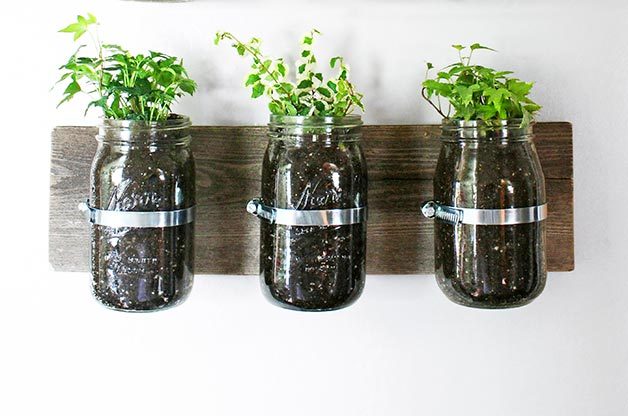
Fill Mason Jars With Flowers
Look around your storage shelves—you’ll likely find many of these handy jars.
- For your next picnic, fill jars with cut lemons and water and add fresh flowers for a simple, elegant centerpiece. Or put Christmas lights inside a few jars as luminarias for an evening party.
- Plant an indoor kitchen garden with your favorite herbs in jars attached to scraps of wood with plumber’s clamps. Mount them in a sunny spot for fresh herbs at your fingertips. Water with care as there are no drainage holes.
- Attach hooks on either side of your kitchen window and use wire to hang a jar from each. You’ll never have to hunt for a place to put freshly cut garden flowers again.
- Paint the inside of the jars with fun colors (you probably have some left over from a project) to make pretty vases.
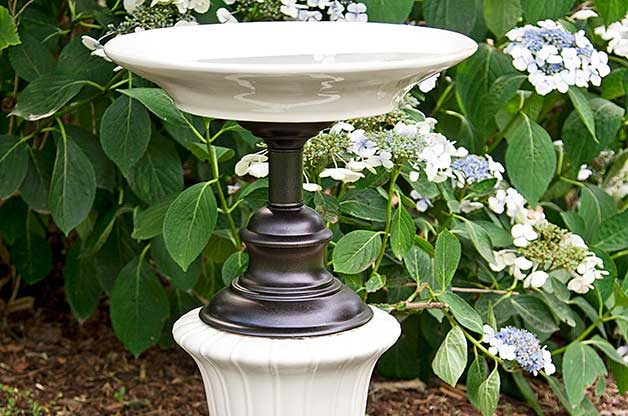
Move Outdated Décor Outdoors
Home decor need a little freshening up? Take old household accessories to the garden.
- Use old lamp bases as pedestals for birdbaths or planters.
- Give old mirrors a new life in the garden. Hang them on a fence or the side of your shed to create dimension in the backyard.
- Rugs a little shabby for indoors? Take them outside to warm up your patio.
- Have a bunch of old keys or metal trinkets in your junk drawer? Hang them with string from an old colander for a fun wind chime.
Bonus Tip: Time to define! The definition of upcycling: reusing old materials to create objects of higher quality or value than the originals.
Learn how to grow a vertical herb harden in a shoe organizer.
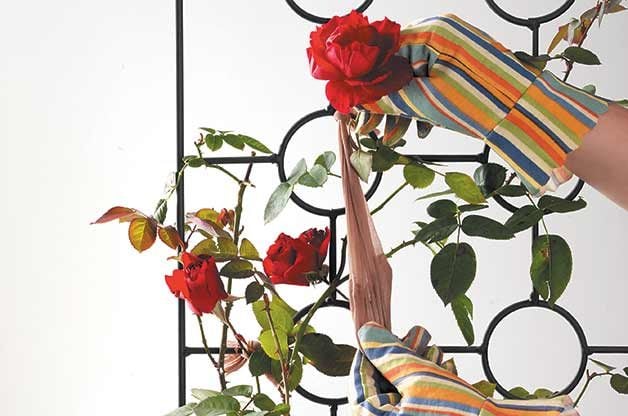
Uses for Old Pantyhose in the Garden
Got a run? Don’t toss torn pantyhose or tights—they’re great garden helpers.
- When planting containers, place pantyhose on the bottom of the pots so water can pass through, but not soil.
- Store out-of-season flower bulbs in a pantyhose leg and hang in a cool, dry place.
- Cut pantyhose in strips and use to tie up and stake plants.
- Push growing melons into pantyhose legs and tie them to a support off the ground to eliminate rot, mold and insect invasion.
- Slip pantyhose over flower heads and secure with twist ties to collect their seeds.
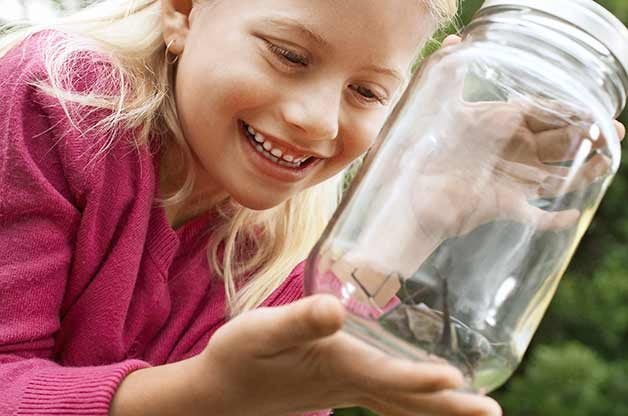
Repurpose Kids and Baby Gear
Little ones quickly outgrow their baby things, but gardeners give baby stuff a second chance.
- Paint the sides of a crib a bright color, such as coral or aqua, and lean it up against your house as a trellis. Colorful cribs can also conceal an unsightly protrusion, like an air conditioner or electrical box.
- With a few simple tweaks, an old changing table works wonders as a potting bench. Learn how to make a pallet bench for your patio.
- No need for that old diaper bag? Hang it on your potting bench for a handy place to stash gloves, tools or other small items.
- Protect plants from frost with a crib sheet. These mini sheets are perfect for planters, raised beds or other smaller garden spots.
- Have your kids outgrown their sandbox? Add drainage holes to the bottom, and you’ve got a new herb planter.
- Going on a firefly or bug hunt? Keep critters in a mason jar with a piece of pantyhose held with a rubber band on the top so the insects can breathe.
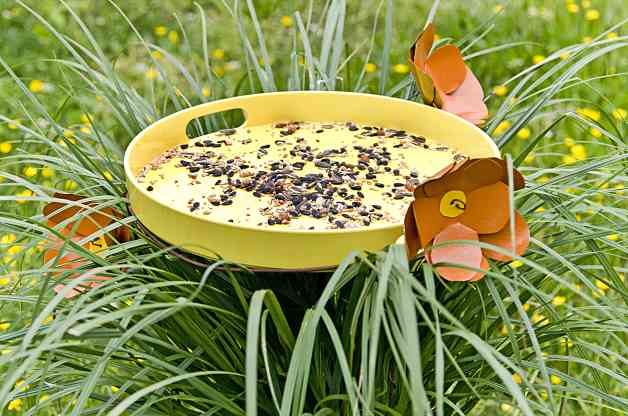
Creative Uses for Dollar Store Deals
Colorful spray bottles: Use them to mist tender seedlings or to hold homemade weed killers or organic fertilizers. Be sure to label them.
Glass vases, plates and small decorative stones: When stacked and glued together, these make attractive DIY birdbaths or feeders.
Kids’ outdoor toys: Keep your kids busy (and helpful) by giving them garden tasks. They’ll love having their own garden tools.
Craft sticks: Mark these with a waterproof pen and use them as plant identifiers.
Sponges: Keep moisture in by placing sponges in the bottom of planters.
Next, learn how to turn a birdbath into a mini fairy garden.
What can birds eat? Birds visit backyard bird feeders for seed, peanuts, suet, mealworms and more, but you can also feed birds occasional treats from your kitchen. Just look in your pantry or refrigerator for these kitchen foods that birds will love.
Apples
Birds that eat apples: Eastern bluebird, pine grosbeak, gray catbird, northern cardinal, northern flicker, American robin, scarlet tanager, cedar waxwing and red-bellied woodpecker.
Serving suggestion: Slice them up and remove the seeds. Or slice them in half, scooping out part of the fruit and filling with sugar water, and skewer one on a feeder to attract hummingbirds.
Bananas
Birds that eat bananas: northern cardinal, gray catbird, Canada jay, scarlet tanager.
Serving suggestion: Remove the peel and cut in half lengthwise.
Psst—here’s 10 foods you aren’t feeding birds yet.
Eggshells
Birds that eat eggshells: Any bird eating your seed, as well as purple martin and barn and tree swallow.
Serving suggestion: Bake clean shells at 250 degrees for 15 minutes. Crush and set out in a dish, or mix in birdseed. They’re a fine source of calcium for egg laying.
Follow these tips for a successful nesting season.
Melon, Pumpkin and Squash Seeds
Birds that eat melon, pumpkin and squash seeds: Northern cardinal, evening grosbeak, red-breasted nuthatch, tufted titmouse.
Serving suggestion: Roast seeds in oven first. Do not apply salt or seasonings.
Learn how to recycle pumpkins for birds and wildlife.

Peanut Butter
Birds that eat peanut butter: Too many to name, including black-capped chickadee, brown creeper, white-breasted nuthatch, wood thrush, wrens and woodpeckers.
Serving suggestion: Drop a dollop in a dried-out orange half left from oriole season, or spread over a pinecone.
Discover what birds eat oranges from fruit bird feeders.
Raisins
Birds that eat raisins: Eastern bluebird, northern cardinal, gray catbird, northern mockingbird, orioles, American robin, scarlet tanager, brown thrasher, wood thrush, cedar waxwing, and red-bellied and red-headed woodpecker.
Serving suggestion: Soak raisins in warm water first so they’re soft and easier for birds to bite.
P.S. Raisins are also a great addition to suet. Check out our guide to making suet for birds.
Did you know that blue is the most popular color? It’s certainly my favorite, and my flower garden often reflects that. Blue flowers can be surprisingly hard to find, though. To me, that just makes them all the more special. I love to pair blue flowers with pink or orange blooms for a wonderful contrast. A garden full of cool white and blue flowers is also a balm for the eyes on a hot summer day. If you’d like to add more blue blooms to your garden this year, here are some to seek out.

Balloon Flower
Platycodon grandiflorus
Zones 3 – 8
Be patient with this blue flower. It blooms in the second year when grown from seed. The blue flower buds look like balloons before opening. Check out the top 10 classic yellow flowers to grow.

Cornflower
Centaurea cyanus
Annual
Perhaps the bluest of all blue flowers, cornflower is usually grown from seed. This plant is also commonly known as bachelor’s button. Psst—we found easy flowers anyone can grow.
Delphinium
Delphinium
Zones 4-8
The blooms also come in pink and white, but delphiniums are some of the best blue flowers available. Check out 10 gorgeous green flowers for your garden.

Statice
Limonium
Annual
This blue flower is commonly grown for dried arrangements and bouquets. Statice also attracts butterflies. Learn how to arrange fresh cut flowers like a pro.

Morning Glory
Ipomoea
Annual
Look for ‘Heavenly Blue‘ for the best blue blooms. Be advised that this vine can be somewhat aggressive. Check out the top 10 vines for hummingbirds.
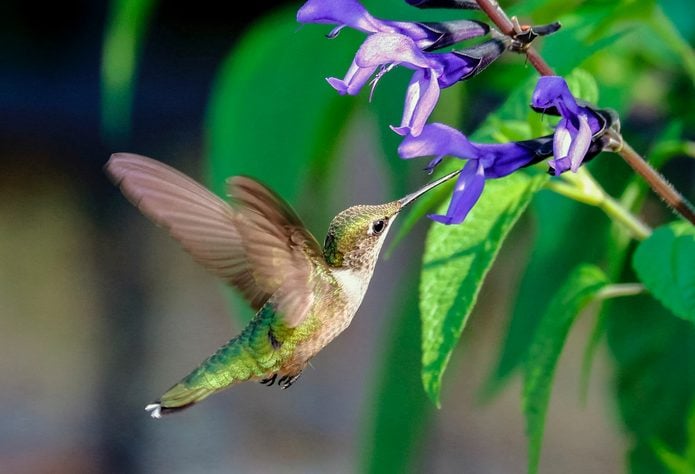
Salvia
Salvia sp.
Annual
There are many blue salvia species, including black and blue salvia, mealycup sage, pitcher sage, playin’ the blues salvia, and meadow sage. This variety makes it easy to find the right ones for your garden. Also try these super fragrant flowers that pollinators love.
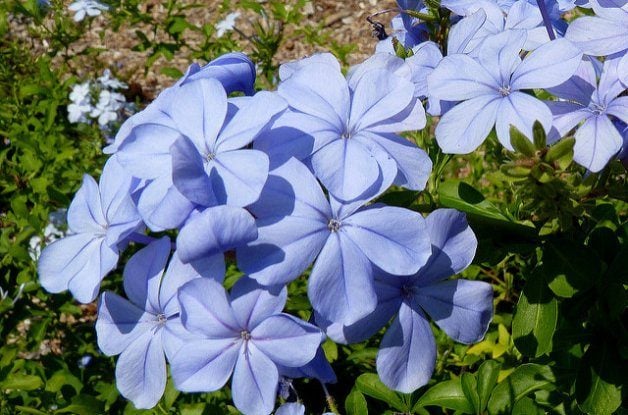
Plumbago
Plumbago auriculata
Zones 9-11
This sprawling shrub with blue flowers thrives in heat and full sun. Southern gardeners will have the most success with plumbago. As a bonus, it is drought-tolerant once established. Check out more drought-tolerant plants that can handle dry weather.
Blue Cardinal Flower
Lobelia siphilitica
Zones 4-9
Cardinal flower comes in bright red and cool blue. This plant, which is beloved by hummingbirds and other pollinators, prefers moist soil. Psst—we found the prettiest purple flowering plants to grow in your garden.
Blue Daze Flowers
Evolvulous
Annual
Here’s another good choice for gardeners who are looking for true-blue flowers. This plant loves sun and hot weather, and will not bloom as well in shade. Grow blue daze in a container or hanging basket, or use it as a ground cover. Try more easy plants you can grow in containers.

Spiderwort
Tradescantia sp.
Zones 3-9
A native wildflower, spiderwort boasts bright yellow stamens that emphasize the blue flowers. Also consider these easy-to-grow native plants.

Virginia Bluebells
Mertensia virginica
Zones 3 to 9
This wildflower of the East and Midwest makes an ideal companion plant for daffodils and hostas, then dies back until the next year. Grow Virginia bluebells in humus-rich moist soil and the plants will self-sow into a colony. This early-spring bloom provides nectar for bees and other pollinators.

Early Scilla
Scillia mischtschenkoana
Zones 4 to 7
If you’re into cool blue hues and want plants that are super easy to maintain, seek out early scilla. This low-growing plant features star-shaped white blossoms striped with blue. Early scillia grows in full sun to light shade and spreads by offsets and self-seeding. Plant the bulbs in autumn for beautiful blooms from late winter to early spring.

It’s chilly at dawn in the desert, even though blazing heat will arrive before midday. To the east, stark outlines of cactus and thorny trees stand against the growing light. And on all sides, the air is alive with the songs of desert birds. The deserts of the Southwest provide excellent birding. These arid lands support a rich variety of birds, including some birds that live nowhere else.
Sources of Water for Desert Birds
Although water is essential for survival, many desert birds are adapted to exist with very little of it. Black-throated sparrows, found all over the Southwest, go weeks or even months at a time without drinking any water at all. They get enough moisture from consuming seeds and insects. Where doves live in desert country, they satisfy most of their moisture needs by eating cactus fruits. But they also fly long distances mornings and evenings to visit streams, ponds or other water sources.
Some widespread birds found in other habitats also live in deserts. For example, northern cardinals are usually thought of as backyard and forest birds of the eastern states, but they live in southern Arizona, too. Because they need more water, cardinals primarily stay along rivers and streams throughout the desert. A close relative, the pyrrhuloxia—a gray and red beauty often called a desert cardinal—lives along the same streams, also moving into much dryer zones that cardinals avoid.
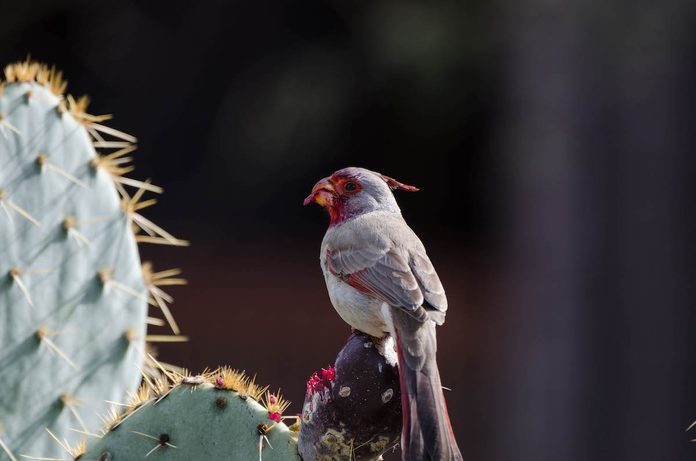
What Do Desert Birds Eat?
Food is sometimes scarce in arid country, and birds have their own ways of coping. One of the most remarkable southwestern species, the greater roadrunner, eats just about anything it can catch. Roadrunners are famous for eating snakes (even rattlesnakes!) and lizards, but they also go after insects, spiders, scorpions, mice and even small birds. While rather like birds of prey that dash around on foot, they actually belong to the cuckoo family.
Costa’s hummingbird, the only member of its family adapted to living in North American deserts, likes flower nectar just as much as its relatives do. But flowers are scarce in dry habitats, so this hummingbird moves with the seasons, migrating east and west in search of flowering plants. Another mobile bird, the glossy black phainopepla, feeds on berries, and it travels from streamside thickets in summer to clumps of mistletoe in the desert at other seasons.

Desert Bird Nests
Birds are creative when hiding their nests in the sparse, open vegetation of the desert, One popular choice is a type of cactus called cholla, which looks like a short jumble of stout branches covered with sharp spines. Humans have a hard time even walking past a cholla without being poked. Many birds build their nests deep within the center of this cactus, and they fly in and out without getting stuck. The big boldly marked cactus wren often chooses cholla as the site for its bulky nest. And the curve-billed thrasher, a yellow-eyed bird with a sharp whit-wheet! call, also favors cholla. In Arizona, a scientist once found a large cholla cactus containing five old cactus wren nests, four old thrasher nests, and another nest still occupied by a brand-new family of thrashers.
Many desert birds place their nests on the ground or in short thorny trees like mesquites or acacias. Another drought-lover, the yucca plant, which looks like a bunch of green daggers sticking out from a central stalk, is a favorite nesting site for the colorful Scott’s oriole. The most distinctive nesting site is the saguaro, a giant cactus with upcurved arms that stands up to 60 feet tall. Woodpeckers climb the saguaro trunk as if it were a tree, and they dig holes in it for nesting cavities.
The gilded flicker and Gila woodpecker, well-adapted to desert life, usually create a new nest hole every time they’re ready to raise a family. Later, these cavities serve as nesting sites for other birds like purple martins and brown-crested flycatchers. The elf owl, the tiniest owl in the world, often lives in these holes in the largest cactuses. As darkness falls, an elf owl may sit at the entrance to its nest, making little yelping and chuckling sounds, before it flies out to hunt for its next insect meal.
Learn about 8 different kinds of bird nests and how to spot them.
How to Attract Desert Birds
In southwestern cities and towns, the best landscape plants are natives, already adapted to local conditions. People who fill their gardens with native desert plants will discover that native birds move right in. The verdin, a tiny gray sprite with a yellow head, flits through backyards throughout the dry zones. Colorful Gambel’s quail strut into suburbs and parks. White-winged doves are often more common in southwestern towns than they are out in more rural habitats. So it’s possible to do some desert birding even without a long trek into the wilderness. Whether you live in the Southwest or you’re visiting from far away, if you get a chance to explore desert country, you’ll find that these arid lands hold many treasures—including the feathered kind.
Next, learn about beach birds and beach birding locations.
12 Desert Birds You Should Know
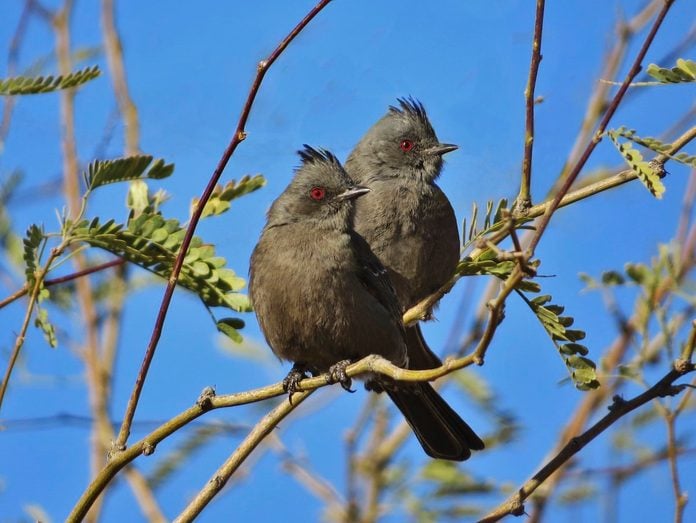
Phainopeplas
This species rarely drinks water. These unique-looking crested birds get most of the water they need to survive from eating mistletoe berries.

Black-Throated Sparrow
The sharply patterned black-throated sparrow is a true desert bird, often going many days without water and living long distances from a water source.

Gambel’s Quail
These birds are at home in urban and suburban areas, wandering into parks and even backyards to eat sunflower seeds, millet and cracked corn from platform or ground feeders.

Greater Roadrunner
Roadrunners are not picky eaters. Almost anything they catch in the desert, including rattlesnakes, may become dinner.

Curve-Billed Thrasher and Cactus Wren
Both the curve-billed thrasher and cactus wren are skilled at slipping through the sharp spines of cactus thickets, choosing to build nests and raise their young there.

Gila Woodpecker
This noisy desert bird draws attention as it excavates tree trunks and saguaro cactuses for nesting cavities. They’re sometimes spotted at hummingbird feeders, but Gilas primarily forage for fruit and insects, gleaning them from cactuses, trees and other plants.

Scott’s Oriole
Scott’s orioles are found from eastern California and northern Utah to the Hill Country of central Texas. They’re especially drawn to areas with lots of yucca plants, building their nests among the long, daggerlike yucca leaves.

White-Winged Dove
Mourning doves are sometimes confused with white-winged doves. You can tell white-winged doves apart by their namesake white wing stripe.
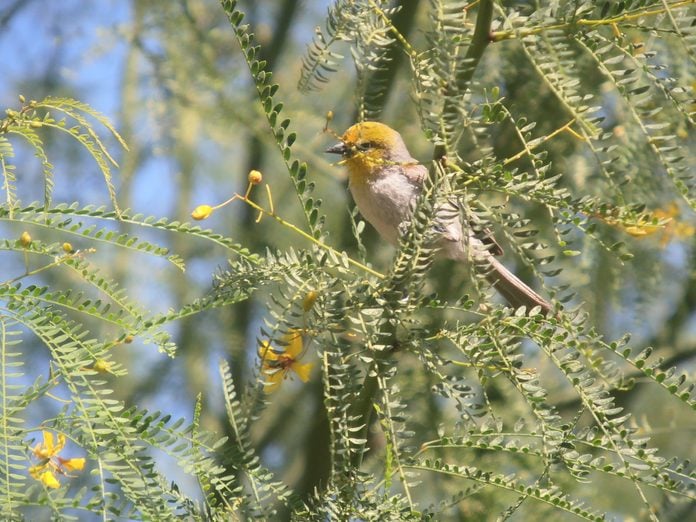
Verdin
This resident of the desert Southwest likes open habitats, and it will readily come into yards that have a few native trees and shrubs such as mesquites, acacias or palo verdes. It feeds mostly on insects, so it’s not attracted to birdseed. But it also likes nectar, so a garden with native flowering plants may draw it in. The verdin is also a frequent visitor to hummingbird feeders.

Costa’s Hummingbird
You’ll only find these hummingbirds in the deserts of the southwest. The males are known for their vibrant purple face and throat feathers and songs, which sound like a thin piercing whistle.
4 North American Deserts to Explore
North America’s major deserts are all very dry regions, but they’re defined partly by when it rains.
Chihuahuan Desert
Covering large areas of western Texas and New Mexico, rain falls mainly in summer here, which supports a sparse growth of grass, small bushes and scattered cactus.
The Mohave Desert
In southeastern California and neighboring states, rain falls occasionally in winter.
Great Basin Desert
Centered on Utah, this sagebrush country gets most of its precipitation in the form of winter snow.
Sonoran Desert
Summer and winter are considered rainy seasons, which means this southern Arizona desert supports the most plant life, with a wide variety of cactus, shrubs and short trees.
Next, check out the most commonly sighted bird in every state.

Patricia Radder of Westfield, New York, shared this oriole nectar recipe with Birds & Blooms. “A local bird supply store was handing out this recipe for a homemade special oriole nectar. It was an instant favorite when the Baltimore orioles returned to our feeders in spring,” she says.
Want to see more orioles in your backyard? Give this recipe a try!
Oriole Nectar Recipe
Ingredients
- 1 cup grape jelly
- 1 cup water
- 1/2 cup white sugar
- juice from half an orange
Combine all ingredients and bring to a boil. Simmer, stirring occasionally until sugar is dissolved. Cool to room temperature and use immediately or store in the refrigerator for future use.
This oriole nectar recipe combines some of orioles’ favorite foods and is sure to be a hit at your oriole feeders. As a bonus, you may also attract other birds like tanagers. Learn what birds like to eat oranges.
Psst—you can also fill your oriole feeders with sugar water just as you would for hummingbirds. Mix one part sugar to four parts water.
Next, get more tips to attract orioles to your backyard and learn the 8 types of orioles to look for in North America.
With elegantly shaped flowers in bright colors, some of them offering intoxicating scents, it’s easy to see why lilies are beloved among gardeners. Lilies are simple to grow—if you can keep the rabbits and deer away. Lily flowers bloom from spring to fall, depending on the species, and can make wonderful bouquets. If you want to know about the different types of lilies you can grow, here’s a helpful guide to help you out.

How to Identify Zebra Swallowtail Butterflies
Zebra swallowtail butterflies are boldly zebra striped in black and white with red accents. Wings have bold black stripes on a white or teal-white background. Hindwings feature a red stripe on the underside and a lengthy tail. A red spot at the base of the wings creates a place for predators to aim away from the tiny body, increasing chances of survival. Adults that emerge in summer tend to have even longer tails than springtime broods. Their wingspan is 2 1/2 to 4 inches. Check out 6 common swallowtail butterflies you should know.
Gardening for Zebra Swallowtail Butterflies
Host Plants
As caterpillars, they feed on the leaves of the small pawpaw tree or others in its genus. The pawpaw tree is common in shady woods, especially in the south. Check out the top 10 butterfly host plants to attract pollinators.
Backyard Nectar Plants
These butterflies enjoy nectar from blueberry, blackberry, lilac, redbud and milkweed. Check out more summer nectar flowers that attract butterflies.

What Do Zebra Swallowtail Caterpillars Look Like?
The caterpillars vary in color. Some are mostly green, while others are greenish or black with yellow stripes. Learn how to plant a caterpillar cafe in your butterfly garden.
Where Do Zebra Swallowtails Live?
This species typically inhabits wide open areas to feed. To breed, it travels to wooded spaces around swamps and rivers. You’re most likely to see these butterflies in southern states. They range from the eastern parts of the Great Plains to the southern parts of the New England states.
Range Map

Peppers add a tantalizing jolt of flavor to your cooking. While it’s getting easier to find a variety of fresh and dried peppers at the grocery store, it’s much more fun and economical to grow your own. Start seeds indoors at least eight to 10 weeks before transplanting them into your garden, or look for starter plants at your garden center. Check out these seed catalogs for new varieties. By mid- to late summer, you’ll have ripe peppers ready to pick. And then the real fun begins… eating them! Here are the best peppers to grow.
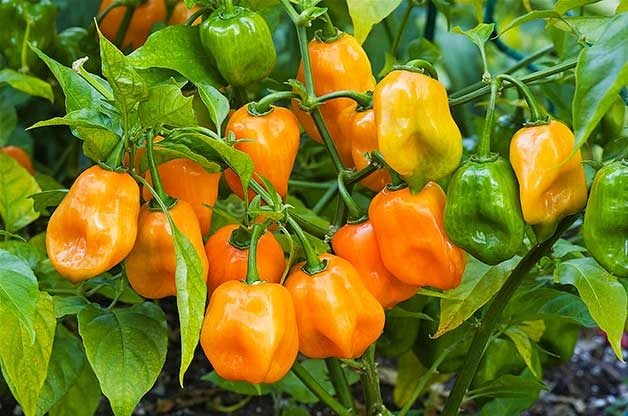
Habanero
If you’re looking to fire up your food, throw in some habaneros. These small, wrinkled orange peppers are intensely hot with a slightly sweet flavor that is strongest when the pepper is used fresh in salsas or salads. Cooking will mellow out the heat somewhat. Habaneros require a warm environment to encourage the seeds to sprout, and the growing season is long. But patience pays off with these glowing nuggets.
Why we love it: It seems that exciting new varieties of habaneros are being developed all the time… and they’ve even hotter. I’ve especially enjoyed growing and eating the beautiful chocolate habanero.
Check out the top 10 best tomatoes to grow.
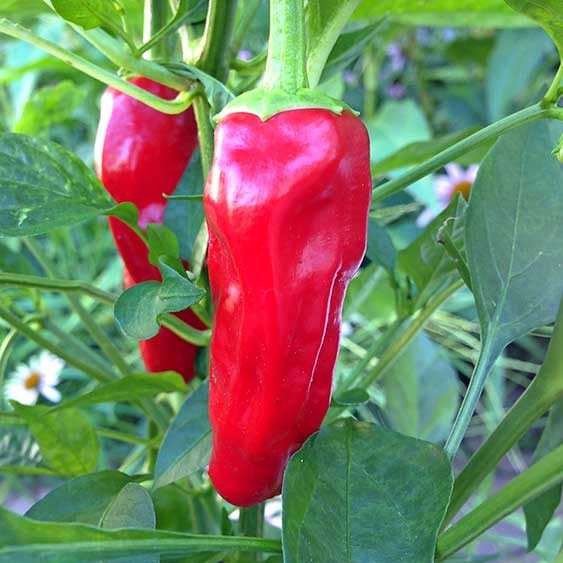
Anaheim
Even if this annual didn’t grow to a height of 20 inches, it would still be a showstopper, thanks to its brilliant scarlet fruit. It thrives in containers or beds and is a fantastic performer through summer and fall.
Why we love it: Anaheim peppers are often used fresh to make salsa verde. The large size also makes them perfect for chiles relleno, the popular stuffed, battered and fried Mexican specialty.
Check out 10 fast-growing vegetables you can harvest quickly.
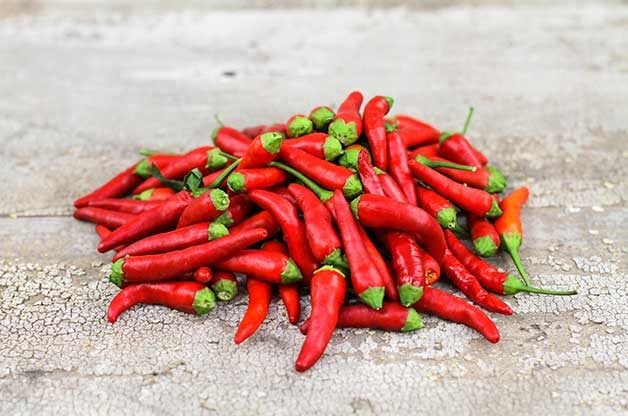
Thai
If you crave spicy noodle dishes from your favorite Asian restaurant, this is the pepper for you. As the name suggests, these peppers originated in Thailand, and they are hot, hot, hot. The slender, 1/2- to 1-inch peppers ripen from green to bright red.
Why we love it: The plant stays small, so it’s a wise choice for ornamental use on your patio. But don’t be afraid to slice up a few Thai peppers and toss them into your stir-fry or curry. They also keep well when preserved in oil or vinegar.
Check out more easy plants you can grow in containers.
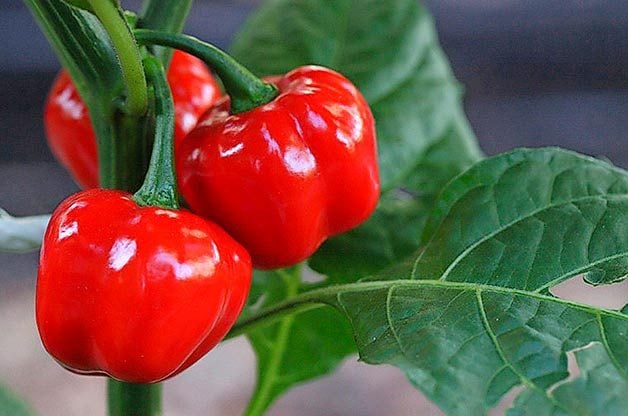
Scotch Bonnet
These fruity fireballs look similar to habaneros, but they are shorter and stouter, shaped like a little hat or bonnet. The plants are very slow-growing. If you want to have mature red peppers before frost in a northern zone, start the seeds indoors very early. I’ve grown Scotch bonnet plants in containers so I could bring them inside on chilly Wisconsin autumn nights.
Why we love it: I love spicy Caribbean cuisine, particularly jerk chicken. Along with allspice, these slightly sweet but blazing hot peppers are a key ingredient in every standout jerk recipe.
Check out the top 10 herbs to grow for cooking.
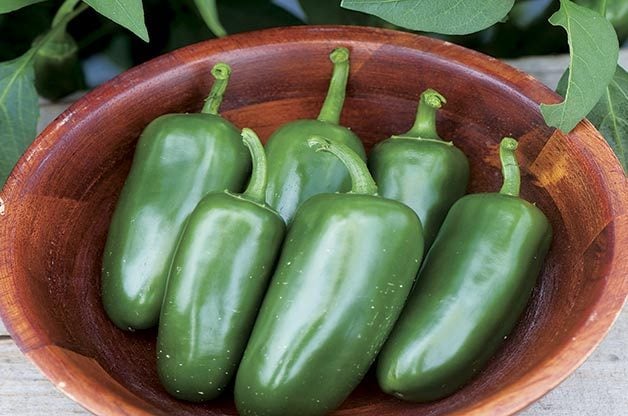
Jalapeño
Make space for several of these simple-to-grow plants in your garden. Jalapeños mature in 75 days, quicker than many other hot pepper varieties, so they’re a good choice for northern gardeners. If you don’t pick them right away, they’ll turn red, but they taste fabulous either way! Dry and smoke jalapeños to make chipotle peppers.
Why we love it: The dark green pepper is one of the best for stuffing, grilling, wrapping in bacon, pickling or just eating raw on burgers and tacos.
Try these vegetables that grow well in shade.
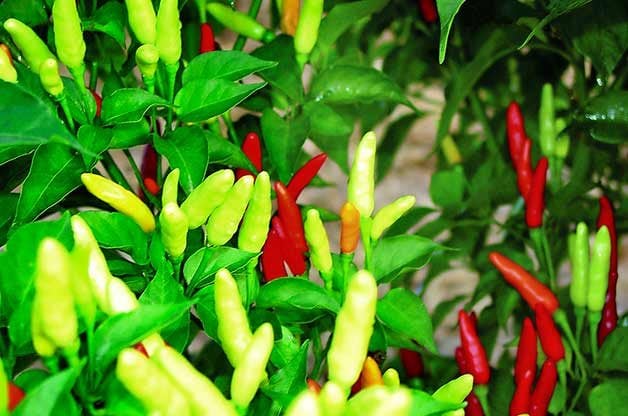
Tabasco
The iconic smoky, vinegary hot sauce is made with Tabasco peppers grown on tiny Avery Island in southern Louisiana, about 140 miles west of New Orleans. Tabasco peppers require 80 to 100 days to reach maturity; they grow best in hot, humid weather. The prolific plants will be covered in small, shiny red peppers. If your growing season isn’t long enough, try growing Tabasco peppers in a container in a sunny spot.
Why we love it: You might not be able to crack the famously secret Tabasco hot sauce recipe, but why not have fun trying?
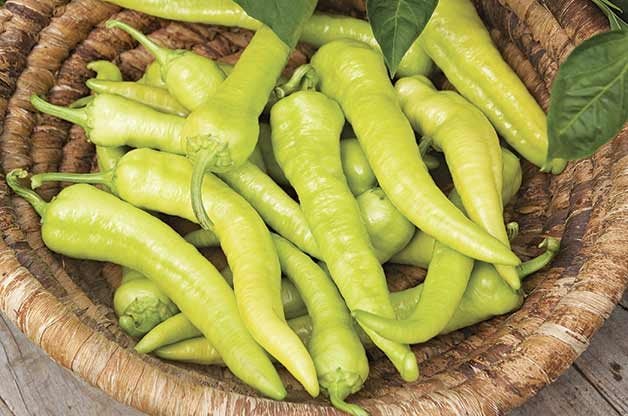
Pepperoncini
Want to pickle peppers or make giardiniera? Then leave room for these Italian favorites in your garden. Plants produce plenty of 5- to 6-inch light green peppers. Their pale color will change to bright red if you wait to pick them, but their flavor stays sweet and slightly spicy.
Why we love it: Pepperoncini are ideal for chopping up and throwing into a salad or piling onto a hot Italian beef sandwich.
Short on space? Check out the top 5 tips for growing tomatoes indoors.
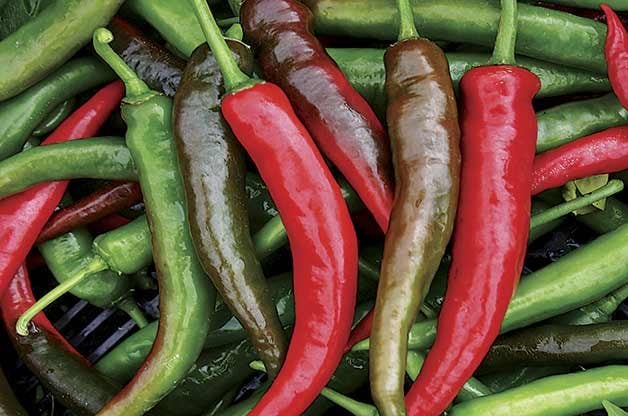
Cayenne
Even if you’ve never seen these long, skinny, curled peppers growing, you probably have some dried cayenne in your spice rack. These peppers start out green but aren’t ready to harvest until they turn bright red. Because of their thin walls, they can be dried easily to cook with year-round or used as decoration.
Why we love it: A healthy dash of cayenne pepper spices up chili, stew or barbecue.
Learn how to create a windowsill herb garden.
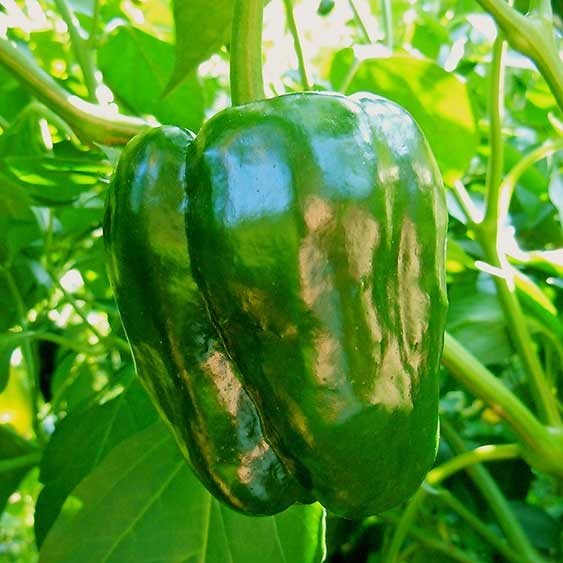
Poblano
These large, dark green, slightly sweet peppers are known by two names in Mexico: poblano when fresh and ancho when dried. They ripen to a deep, almost black color. Their heat is mild, and the bushy, easy-to-grow plants are heavy producers.
Why we love it: This pepper tastes wonderful when roasted and is the classic choice for chiles relleno. Ancho peppers are the main ingredient in Mexican mole sauces.
Learn about edible flowers: what flowers can you eat?
Cubanelle
Looking for a more flavorful alternative to bell peppers with a whisper of heat? Try Cubanelles. Plants produce peppers that are brightly colored and uniquely shaped.
Why we love it: These sweet peppers are delicious in Cuban, Puerto Rican and Dominican recipes.
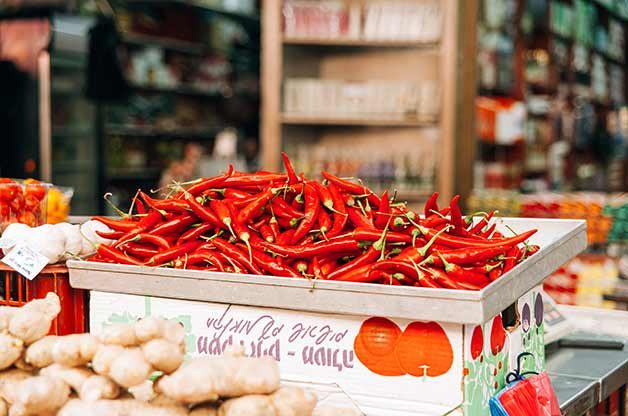
Bonus Tips for Productive Peppers!
- Start seeds indoors at least eight to 10 weeks before your last spring frost date.
- Pepper seeds need heat to sprout; around 80 degrees is optimal. If you don’t have a heat mat, try placing them above your refrigerator.
- Some of the hottest peppers can take up to a month to germinate. Once they do sprout, place them under grow lights for about 16 hours per day.
- Peppers thrive in warm temperatures. Once plants have at least two true sets of leaves and the danger of frost has passed, begin to harden off by taking them outside for an hour or two in a sheltered location. Exposing them to too much sun will scald the leaves, but cold air can slow growth, so be cautious.
It’s hard to miss the cheerful yellow and contrasting black and white wing markings of male American goldfinches, especially when they’re crowded around your backyard bird feeder. However, yards with more lawn grass than native flowers and shrubs are not a natural fit for goldfinches. These birds prefer open, weedy fields with shrubby edges. Learn how to attract goldfinches with plants and bird feeders that will make them give your yard a chance.
How to Attract Goldfinches to Bird Feeders
Goldfinches are are big fans of bird feeders. Although goldfinches will eat most small seeds, they love thistle (Nyjer) and sunflower seeds. Keep goldfinches coming back by replacing uneaten food every three to four weeks. Make sure the seed stays dry. Most tube and mesh feeders are fine; a sock feeder also works well. Check out the best finch feeders to serve thistle seed.
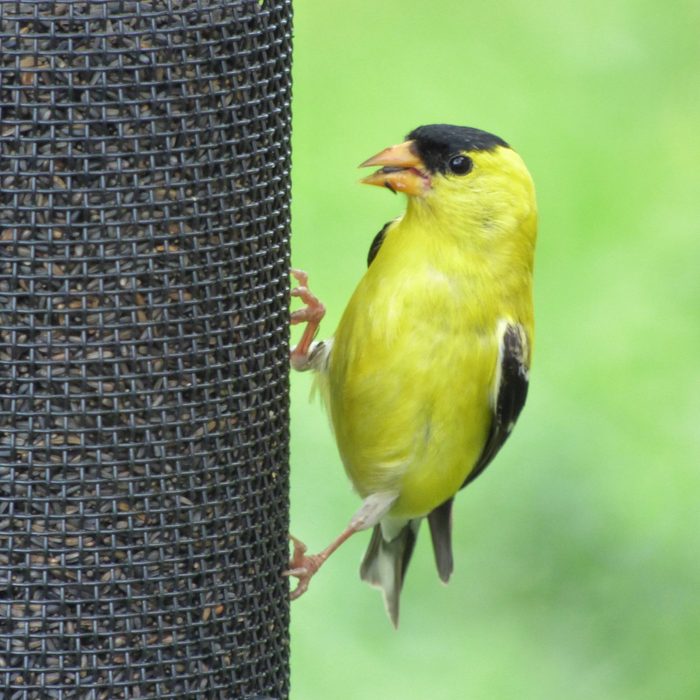
What Do Goldfinches Eat?
The goldfinch diet consists almost entirely of seeds, but these birds also occasionally enjoy the bark of young twigs, fresh tree buds and maple sap. Western red cedar, elm, birch and alder trees will encourage more goldfinches to stop by for lunch. In summer, goldfinches add a few small insects to their diets, but seeds remain at the top of the menu.
Meet the 3 types of goldfinches in the United States.
Do Goldfinches Migrate?
If food is plentiful, American goldfinches won’t typically migrate very far, which means their distinctive per-chick-o-ree call can be heard year-round. But you might not notice them at your feeders. When winter arrives, the males take on a more subtle brown coloring to match the females.
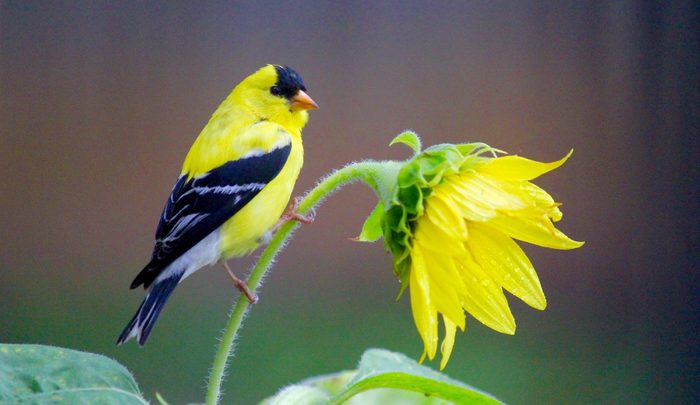
Flowers to Attract Goldfinches
If you’re gardening with goldfinches in mind, seed-producing plants are essential. A few favorites include asters, coneflowers, sunflowers and, of course, thistles. They also gravitate toward grasses and weedy plants. Some bird-watchers also swear that yellow flowers attract goldfinches. And while the ornithological jury is out on that assertion, adding goldenrod, yellow zinnias or blanket flowers to the mix can’t hurt, right?
To identify a few other plant options, I talked with people who spend a lot of time watching birds—wildlife photographers. In her upstate New York yard, photographer Marie Read tends a native plant garden that’s just for the birds. There she plants towering cutleaf coneflowers (Rudbeckia laciniata) for goldfinches, and also sees the birds on her Joe Pye weed and cup plant (Silphium perfoliatum).
As a wildlife photographer, Marie has an appreciation for birds that put on a bit of a show, and the American goldfinch fits that description. “They’re very acrobatic,” Marie says. “They won’t just perch on a flower. Goldfinches cling. They will feed upside down.”
And of course, there’s that thistle. “Thistle is their No. 1 choice—that’s guaranteed,” says another photographer, Dave Maslowski. He and brother Steve have spent five decades shooting wildlife photos, mostly of birds.
Pine Siskin vs goldfinch: Here’s how to tell the difference.
Plants Goldfinches Use to Build Nests
Not only will thistle seeds attract goldfinches, the birds famously use down from mature plants to line their nests. It’s one reason the American goldfinch nests so late in the season, usually between late June and early August. The problem with thistle is that many types are invasive. When planting, look for native plants like field thistle (Cirsium discolor), Flogman’s thistle (C. flodmanii) and wavyleaf thistle (C. undulatum), while also checking to assure the variety isn’t a nuisance in your area. The U.S. Department of Agriculture’s invasive and noxious plant listing at plants.usda.gov is a good resource.
Thistle isn’t the only material female goldfinches use to line their nests. Milkweed, cattails and dandelion are other options, as are willow catkins and cottonwood fluff. But the birds will use whatever is available, says Robyn Bailey, project director of the Cornell Lab of Ornithology’s NestWatch. It’s part of what makes the birds so fascinating: They are incredibly adaptable to their environment. One plant to eliminate from a goldfinch habitat is burdock. While feeding on the seeds, goldfinches can become entangled in the burrs of this plant and die.
Check out 9 proven tips to attract nesting birds.
Add Shrubs to Attract Goldfinches to Nest in Your Yard
Given the goldfinch’s habitat, it should come as no surprise that shrubby is a fair description of their nesting sites. Although goldfinches will nest in taller trees, more typical placement is in a shaded location on a low, dense shrub or tree 3 to 10 feet from the ground, Robyn says. And the birds aren’t specialists. “They’ll use whatever is dominant in their habitats,” Robyn says. “In more swampy areas with tamarack, they’ll use tamarack. In an old field with hawthorn, they’ll use hawthorn.”
More important are the characteristics of the shrubs and trees. “Their nest is very much a cup shape, so if they can get access to a more supported structure they’ll use that,” Robyn says. Goldfinches often build nests in a vertical fork, where three or more branches meet to form the perfect spot for that cup shape. Plants like dogwood, elderberry, buttonbush and hawthorn are common, as are Monterey pine, willow and fruit trees. They’ll even nest in thistle plants that have the right structure, Robyn adds.
For cover before or after nesting season, goldfinches seek out many of those same types of plants, as well as low, dense evergreens, especially in winter.
Learn how to create the ultimate backyard wildlife habitat.




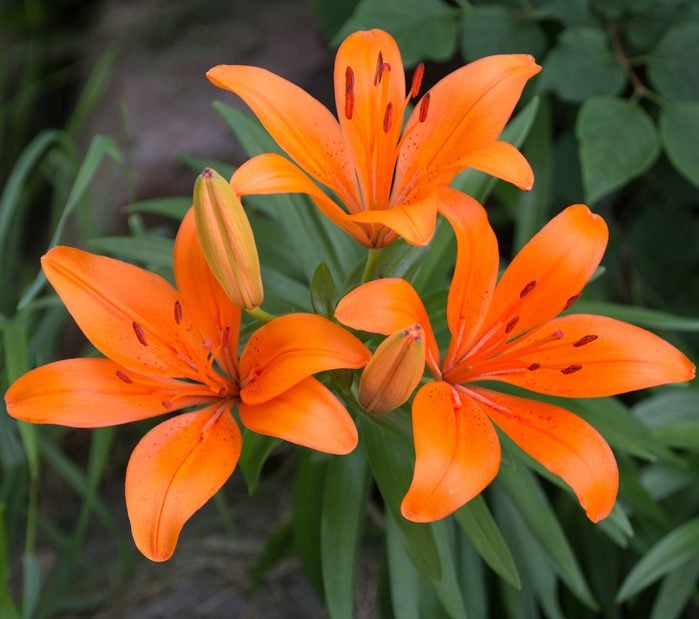





 Canna Lilies
Canna Lilies